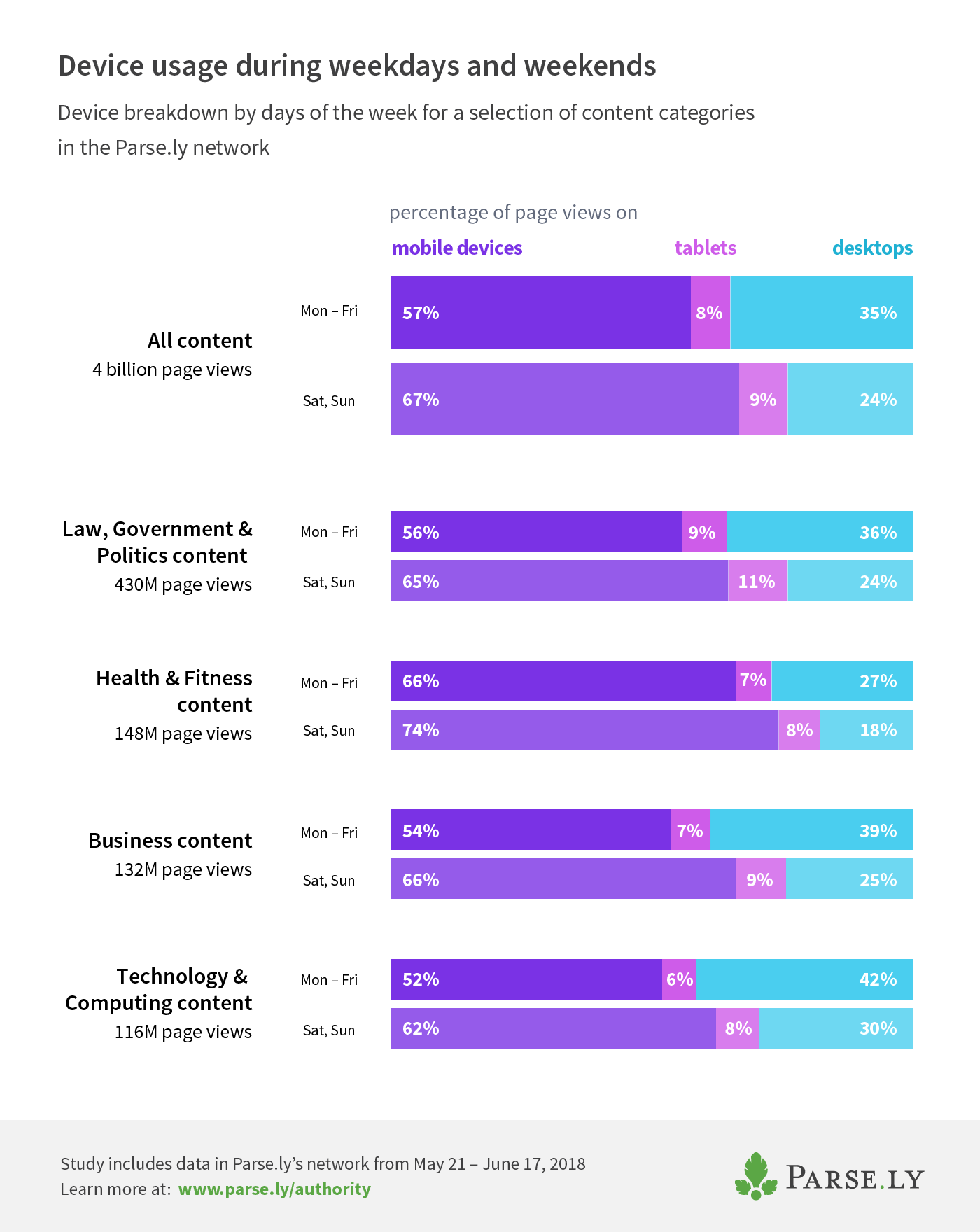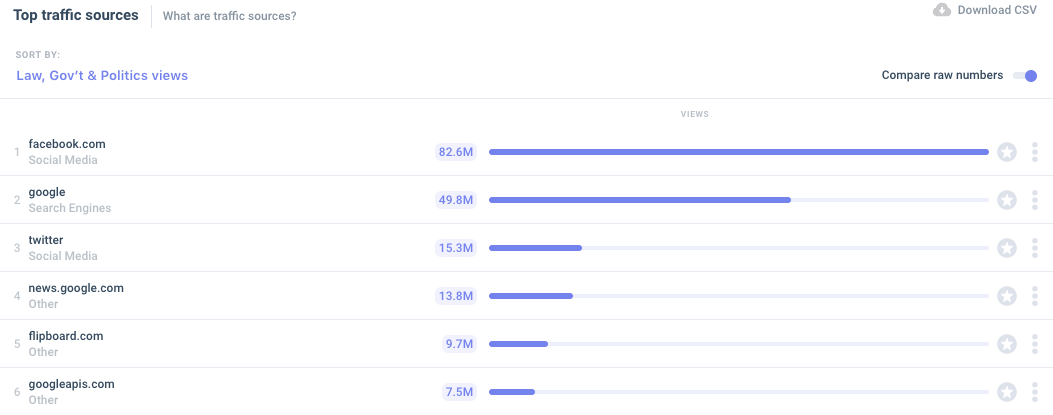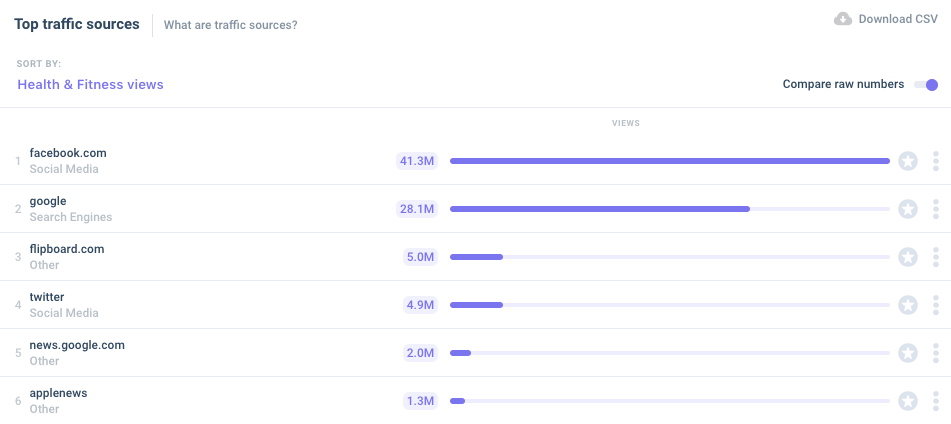What do people read about while they’re at work?

Patterns in traffic show that desktop usage peaks during workdays, tablet traffic increases slightly on the weekends, and mobile usage happens around the clock. When we’re sitting behind desks during the day, we’re looking at different stories than we do when we’re at home or out and about on our phones.
Certain categories of content, such as Technology and Business, see a higher percentage of weekday desktop traffic relative to the average for all content. Other kinds of content, such as Health & Fitness, see an outsized percentage of mobile visitors, especially on weekends.

Let’s take a look at what we can learn from when and where audiences engage with specific kinds of content, according to Currents data.
Business hours are for business
Business and Technology articles are most relevant to the workers who would be glued to their desktops during weekdays. They might also be safe topics to peruse while productively procrastinating during those moments of distraction throughout the workday.
During weekdays, the percentage of readers browsing Business articles on desktop was 4% higher than the average for all content. For Technology articles, it was 7% more.
Publishers produced more articles about Tech and Business during the week than the weekend, which influenced reader behavior further.

Loyal readers of Business news tend to trust the editorial choices of their preferred outlets. Readers found stories from homepages and recommended content within sites more than they did from outside sources like social media and search.
Politics junkies never take a break from their phones
The device breakdown for politics closely matches the average for all content, though with more of a bump in weekend tablet traffic than any other category. The way readers are finding Law, Government, and Politics articles makes sense in light of the mobile vs. desktop trends.

Google search, Google News, and Chrome Content Suggestions (googleapis.com) were major sources of traffic. The nature of the top referrers suggest people are paying attention to push notifications on mobile even over the weekend.
Readers of Health & Fitness content are “all mobile, all the time”
On weekdays, people visited Health & Fitness content via mobile 9% more than the average. On weekends, mobile saw a 7% jump above the average.
A lot of Health & Fitness content is highly visual, which would make sense for its popularity on social and apps with a strong mobile user experience like Flipboard.

The behavior of Flipboard readers offers insight into the mindsets of Health & Fitness readers more generally. From the charts above, Flipboard is the fifth most popular traffic source to Politics content and the third most popular traffic source to Health & Fitness content.
When Flipboard’s Managing Editor, Gabriella Schwarz, conducted a study of millennial Flipboard readers, she found that millennials on Flipboard read about serious subjects such as news, business, and technology. However, they are more apt to share stories about what’s going on in their lives: health, parenting, weddings, and self-care stories.
Just like the subset of millennial readers on Flipboard, the wider Health & Fitness audience may also be keeping tabs on news but engaging with and sharing stories that tie into their personal lives and aspirations. Stories that are tied into people’s identities earn attention around the clock, even when Health & Fitness fans are on the go or enjoying their weekends.
Work mode vs. leisure mode
Those patterns show us that—good news, employers!—people pay attention to topics relevant to their work while sitting behind their desks during the day. However, that doesn’t mean they disengage from their personal interests. They just tend to use their phones to stay connected.
“Mobile traffic is differentiated by mindset or topic,” Parse.ly’s CEO, Sachin Kamdar, noted on a podcast episode. “I know that when I use mobile I’m not doing the same things as when I’m using desktop.”
The devices we use and what we read about vary depending on our mindset: work mode or leisure mode. People care about different things during the week than they do on the weekend, but we don’t have an on/off switch.
What does that mean for content creators? Sharing a Health & Fitness article published during the week on social media on a Saturday might put it in front of the right people. The same goes for placing a Business article on the homepage on a Tuesday. Understanding the modes people are in when consuming different kinds of content reveals potential moments when you can connect with the audience you want to reach.
The data in this piece derives from Currents, a new product that shows what’s holding the attention of millions of people online. Want to explore the data for yourself? Sign up for the waitlist to access Currents beta.